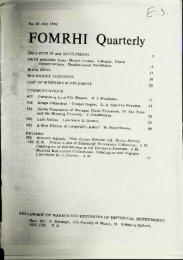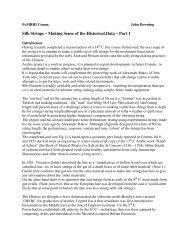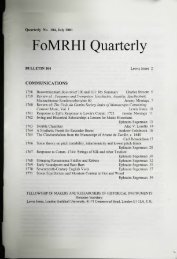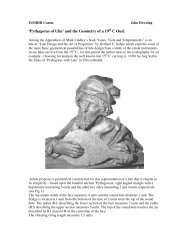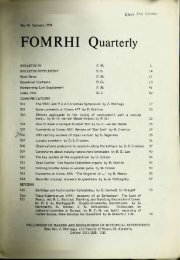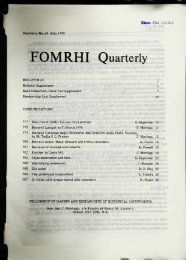• I f - FoMRHI
• I f - FoMRHI
• I f - FoMRHI
Create successful ePaper yourself
Turn your PDF publications into a flip-book with our unique Google optimized e-Paper software.
28<br />
<strong>FoMRHI</strong> Comm. 16 06 Ephraim Segerman<br />
Peg Fitting<br />
It is about time 1 did a nuts & bolts Comm. Well, sort of. I have been updating and<br />
expanding an NRI brochure on instrument maintenance associated with strings. Most of it is<br />
standard procedures, and if explanations are called for, they are usually fairly standard. When<br />
it came to pegs though, I realised that I didn't know how pegs really work, and so had to<br />
figure it out for myself. Being trained as a physicist helped. Following is the peg-fitting<br />
section:<br />
Wood swells or contracts with changing humidity different amounts in different directions.<br />
The swelling is most in the tangential direction (going around the circumference in the original<br />
log), about half of that in the radial direction (going from the centre of the original log<br />
outwards), and hardly at all in the grain direction (along the axis of the original log). Woods of<br />
higher density swell or contract more for the same change of humidity than woods of lower<br />
density, and harder woods are less compressible, so they exert stronger forces against any<br />
hindrance when they change dimension.<br />
Holes that are drilled and reamed in pegboxes go perpendicular to the grain direction. The<br />
cross-section of the hole is round when just reamed, but will tend not to remain so when the<br />
humidity changes. The dimension of the hole along the grain direction hardly changes at all,<br />
but the direction perpendicular to it does. The difference is minimised if the other direction is<br />
the radial one (perpendicular to the rings), but this is not necessarily an advantage.<br />
For strength, pegs are turned so that the grain direction is along the peg shaft. When freshly<br />
turned, the cross-section of the shaft is circular, but when the humidity changes, it tends to go<br />
oval, with the tangential direction swelling or contracting about twice as much as the radial<br />
direction.<br />
Consequently, at any humidity other than that at which the pegbox hole was reamed or the peg<br />
shaft was turned, there is a tendency to have an oval cross-section peg turning in an oval crosssection<br />
hole. This is the norm when we use pegs, and yet they usually still work. If both the<br />
peg and the pegbox were made of particularly hard wood, the peg cannot be made to turn<br />
smoothly if the humidity is not just right. For pegs to work, we need some of the wood<br />
involved to be compressible.<br />
In medieval times, pegs were made of particularly soft hardwoods, and their sponginess made<br />
up for any deficiencies in the shaping of the pegbox hole and the peg shaft. In the Renaissance<br />
and early baroque, with instruments made by professional makers, pegbox holes and pegs<br />
appear to have been more accurately made, and medium-hard hardwoods such as fruitwoods<br />
were used for pe





